NVIDIA Announces Jetson TX1 - A Tegra X1 Module & Development Kit
by Ryan Smith on November 10, 2015 6:50 PM EST- Posted in
- SoCs
- NVIDIA
- Tegra X1
- Tegra
- Machine Learning
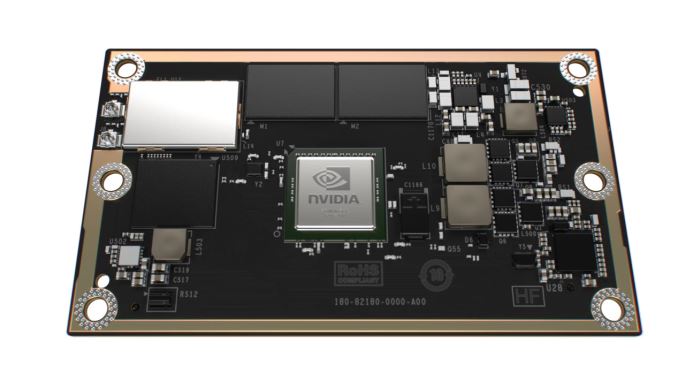
Although NVIDIA’s original plans for Tegra haven’t quite panned out as NVIDIA wanted to – at this point even tablet wins are few and far between – the company has continued to invest in developing their line of ARM SoCs and products built around them such as the SHIELD platform. One of the less public investments NVIDIA has put into Tegra has been on the development kit side; starting with Tegra K1 in 2014, NVIDIA began releasing a full development kit for the Tegra platform. Dubbed Jetson, the TK1 Jetson was a full commercial off the shelf Tegra system containing the SoC, memory, storage, a Linux distribution pre-configured for the board, and all of the necessary I/O interfaces a developer could want. With Jetson NVIDIA was looking to bootstrap the development of products around Tegra K1 by giving developers the means to easily prototype their devices around the dev board, before going into traditional full production.
However since it was a full COTS implementation of Tegra K1, something unexpected happened for NVIDIA: developers started using Jetson TK1 outright as a production board. For small developers doing similarly small product runs, or just projects that didn’t require a highly integrated solution (e.g. embedded systems as opposed to mobile devices), some developers would just stick with Jetson since it meant they could skip system hardware development and focus on software and/or peripherals.
Moving on to the present, after announcing their latest-generation Tegra X1 SoC at CES 2015 and integrating it into some of their own products over the past several months (Drive PX, SHIELD Console, etc) NVIDIA is now rolling out an updated Jetson product based on the X1. The latest Jetson, which NVIDIA is appropriately calling the Jetson TX1, is designed to refresh the platform with the more powerful Tegra X1 SoC and its full ARMv8 AArch64 CPU + Maxwell GPU capabilities. At the same time however, based on their unexpected success as a COTS product, NVIDIA has redesigned Jetson to better serve the COTS market while also continuing to serve the Tegra developer kit market.
The end result is that for its TX1 iteration Jetson has been split in two, and now comes as stand-alone compute module with a separate carrier board for I/O. The Jetson TX1 module itself – which is for all practical definitions Jetson TX1 in its entirety – contains a full working TX1 system. NVIDIA tells us that Jetson TX1 should offer 2-3 times the performance of Tegra K1, particularly where the GPU is involved, and while we don’t have the CPU clockspeed some quick math on NVIDIA’s 1 TFLOPS claim puts the GPU clockspeed at 975MHz (assuming FP16) with the complete module rated for approximately 10W.
Otherwise along with the TX1 SoC, NVIDIA has attached 4GB of LPDDR4-3200, a 16GB eMMC flash module, a 2x2 802.11ac + Bluetooth wireless radio, and a Gigabit Ethernet controller. By providing a complete TX1 system on a board a bit smaller than a credit card, NVIDIA is looking to further the COTS usage of Jetson by giving product developers a smaller dedicated board specifically designed for COTS usage and quick integration into shipping products.
Meanwhile I/O connectivity is now provided by a separate board, be it a product-specific developer design or the official Jetson TX1 carrier board, with the Jetson TX1 using a 400 pin board-to-board connector to attach to other devices. Similar to the original Jetson TK1, the official Jetson TX1 carrier board is designed to offer TX1 as a development kit and contains a full suite of I/O including Ethernet, WiFi + BT antenna connectors, HDMI, USB, M.2, a large number of GPIOs, a camera serial interface with 5MP camera, and a PCIe 2.0 x4 slot. Relative to Jetson TK1, the newer TX1 includes more GPIOs, the camera, a full-size PCIe interface, and it can now work from a more traditional 3.3v power supply.
Moving on, not unlike TX1’s discrete GPU counterparts, with the Jetson TX1 platform NVIDIA is strongly focusing on machine learning and autonomous machines. The company believes that machine learning is the next great frontier for GPUs – both discrete and integrated – and is capitalizing on neural net research that has shown GPUs to be capable of both quickly training and quickly executing neural nets. This is an important differentiator for NVIDIA given their strengths in GPU development (both from a tech perspective and overall SoC GPU performance), and because it is a market that they feel no one else is truly aiming for (or at least competitive in) at this time. The Drive PX system already uses TX1 on this basis, and now with Jetson TX1 NVIDIA is looking to extend that relationship to a much wider group of developers.
Similar to Jetson TK1 then, Jetson TX1 comes with a suite of software and SDKs in order to simplify the development process and to give developers a good starting point for implementing machine learning. Along with the Linux for Tegra environment, NVIDIA is including their cuDNN neural network library and VisionWorks computer vision toolkit. Coupled with other APIs and software packages such as OpenVX and various neural network systems, NVIDIA is aiming to make the Jetson SDK an ecosystem in and of itself.
Finally, along with today’s announcement NVIDIA also unveiled the pricing and availability of the Jetson TX1 module and the full development kit. NVIDIA will begin taking pre-orders for the dev kit on the 12th with kits to start shipping as soon as the 16th, and will sell for $599 retail/$299 education. The dev kits will contain the module, carrier board, camera board, a heatsink-fan for cooling (which we’re told is grossly overpowered for TX1), and all of the necessary cables. Meanwhile the stand-alone Jetson TX1 module for use in commercial products will go on sale in Q1 of 2016, priced at $299 in 1K quantities.


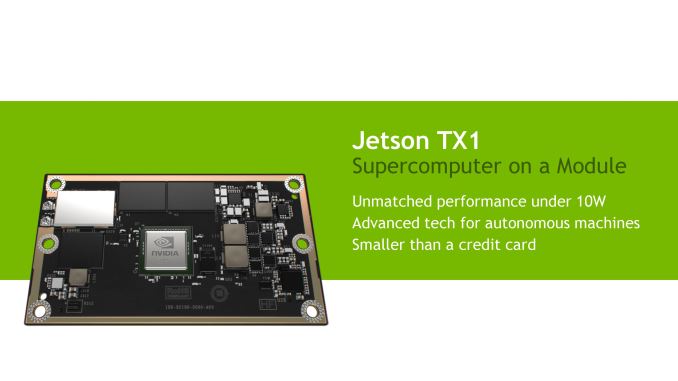
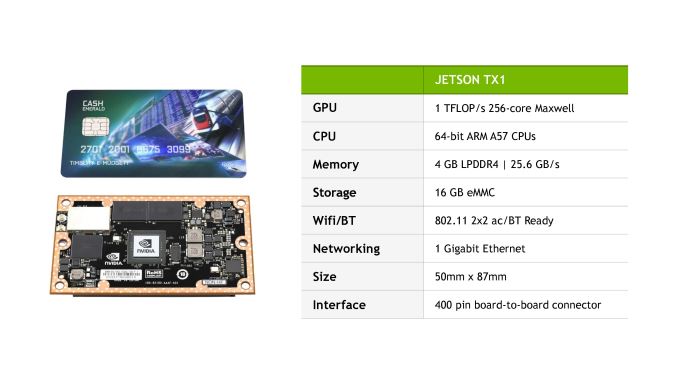
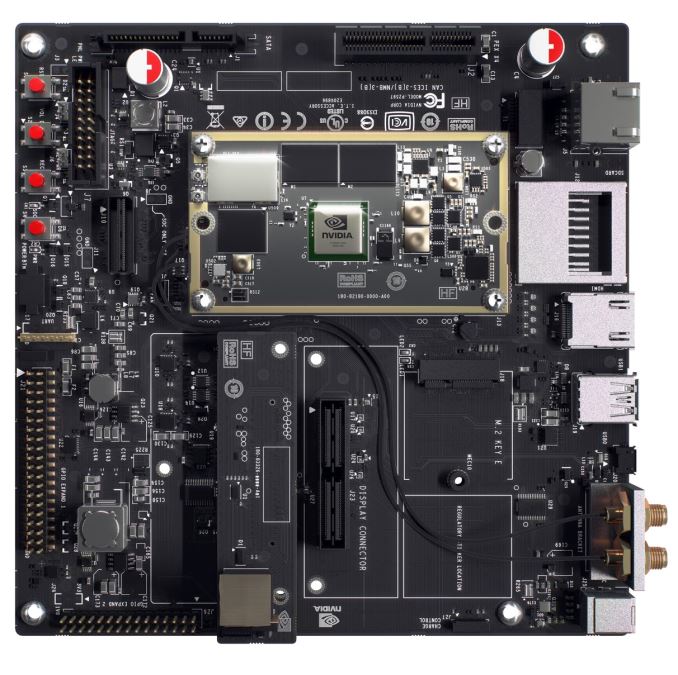
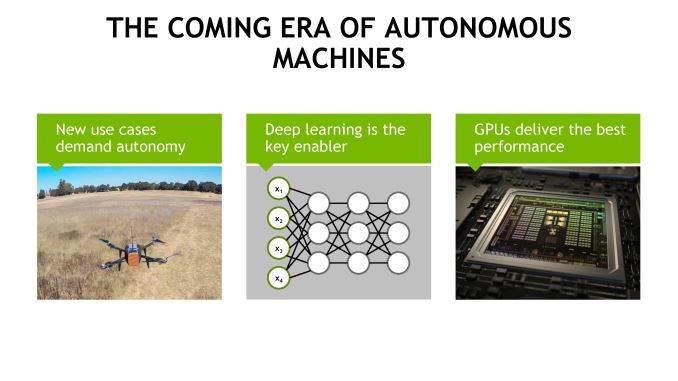
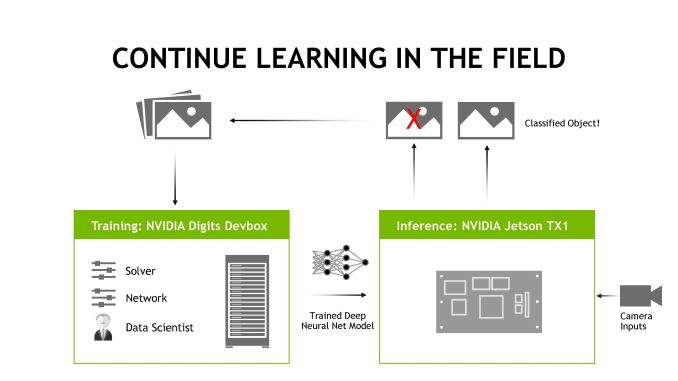
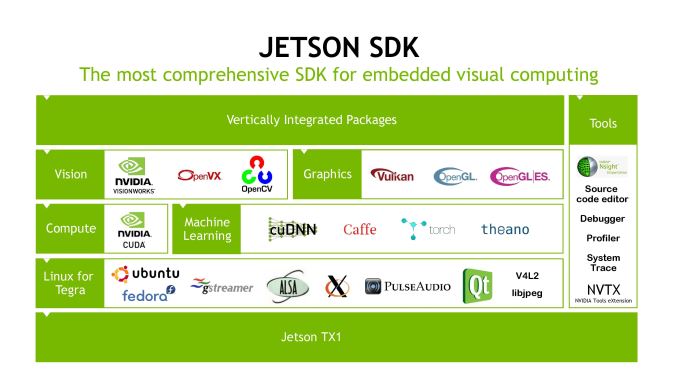
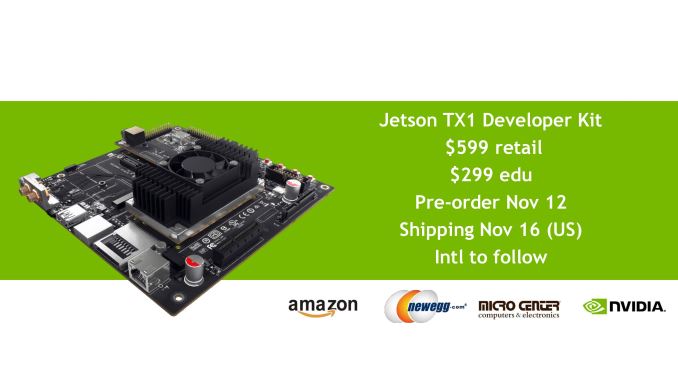














34 Comments
View All Comments
p1esk - Tuesday, November 10, 2015 - link
I'm totally buying one of those as a linux desktop. No brainer at $299 educational pricing.ddriver - Wednesday, November 11, 2015 - link
It is too expensive even at educational pricing level. Cheap nvidia pushing for profit even on such a low volume market as dev platforms... way to go.Buying that for a desktop system? Even at 300$, you can get an ITX board, CPU and RAM and still get a marginally better system.
I was just about to compliment nvidia for making a dev kit that is not huge for once, then I noticed the "motherboard" it plugs into. So the "smaller than a credit card" bullet-point is just shallow marketing, as the SOC module doesn't seem to be usable on its own.
Also, I don't see OpenCL mentioned anywhere, so thanks but no thanks!
KTF26 - Wednesday, November 11, 2015 - link
"So the "smaller than a credit card" bullet-point is just shallow marketing"nvidia may be the king for shallow marketing
but this one isn't
the huge motherboard is good for development phase
but the final product should work without it
the probably bad news here is it looks like you must buy both of them as a package
ddriver - Wednesday, November 11, 2015 - link
It would have been better to put some of the headers on the soc board, and make the big board optional.At any rate, I expect in a few months there will be something like a new ODROID board comparable in performance at like half the price of this one.
As impressive as the 1 TFlop number may seem, this is for FP16, so I don't expect more than 300 GFlops for FP32 and something entirelly pathetic for FP64. So in reality it is only slightly faster than competing GPUs from the same "generation", which should find their way into an ODROID or another similar ARM single board solution.
The base board is not really huge, but it is still too big to put on a typical robot or drone. Would have been nice to be able to use it standalone, but absent the headers and connectors this is not an option.
KTF26 - Wednesday, November 11, 2015 - link
"It would have been better to put some of the headers on the soc board"I don't think they kept it without headers
but I can't tell until I see the bottom of the SoC board
because it looks like there where you connect the peripherals
"I don't expect more than 300 GFlops for FP32"
actually it's 512 GFlops
and forget about FP64, it's maxwell
"I expect in a few months there will be something like a new ODROID board comparable in performance at like half the price of this one."
Agree, they are not alone here
but I hop they make similar dev kit
SoC board with "optional" big motherboard
stetrain - Wednesday, November 11, 2015 - link
Uh, I'm pretty sure the educational price isn't about using it as a simple desktop computer.It's a dev kit, for use in robotics and other embedded development. It seems like something my university's embedded systems lab might buy for research.
The large motherboard for it is again just for development. Most small embedded systems have similar boards that you use for development and programming. The end product that you develop doesn't need all of that extra hardware so you can get by with something a lot smaller.
Samus - Wednesday, November 11, 2015 - link
Yeah, the $299 educational price is good, but the $600 retail price will practically kill any momentum this things desperately needs in the corporate sector where commercial applications are developed. And that's there the money is. For something with a BOM of <$100, a 600% markup is downright unreasonable.ddriver - Wednesday, November 11, 2015 - link
So in your expert opinion, 600$ are gonna be a problem for corporations who develop high tech computation intensive products?Funny thing is, even though the price will not be problematic to any corporation, they could actually score more design wins if they gave those away on the cheap, possibly subsidize the price of those few dev platforms they are going to sell from the sales of the actual hardware for the retail products.
So what's the motivation? Why push for such a ridiculous profit margin on a dev platform, which is not a volume product, when it could hurt the actual volume sells later on?
Samus - Thursday, November 12, 2015 - link
That was kind of my point. They are being cocky charging so much for a devkit when similar kits have sold for <$100 from Intel and Google, and even Microsoft.This isn't a PlayStation developer station or something proprietary where you license the "compiler" it's a platform preview kit if anything. There is no reason to milk it.
edzieba - Thursday, November 12, 2015 - link
$600 is for the devkit (board plus breakout board). If you're purchasing breakout boards from Nvidia in bulk and putting the whole breakout board into your product, you're Doing It Wrong.The intended solution is the same as the RPi Compute Module: you develop with the development kit, and once you have your design working you fab a custom breakout board with only the parts you need (generally integrated into the PCB of your product) then drop in the bare TX1 module.